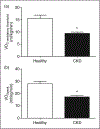Cardiopulmonary exercise testing reveals subclinical abnormalities in chronic kidney disease
- PMID: 29808762
- PMCID: PMC11981665
- DOI: 10.1177/2047487318777777
Cardiopulmonary exercise testing reveals subclinical abnormalities in chronic kidney disease
Abstract
Background Reductions in exercise capacity associated with exercise intolerance augment cardiovascular disease risk and predict mortality in chronic kidney disease. This study utilized cardiopulmonary exercise testing to (a) investigate mechanisms of exercise intolerance; (b) unmask subclinical abnormalities that may precede cardiovascular disease in chronic kidney disease. Design The design of this study was cross-sectional. Methods Cardiopulmonary exercise testing was carried out in 31 Stage 3-4 chronic kidney disease patients (60 ± 11 years; estimated glomerular filtration rate 43 ± 13 ml/min/1.73 m2) and 21 matched healthy individuals (healthy controls; 56 ± 5 years; estimated glomerular filtration rate>90 ml/min/1.73 m2) on a cycle ergometer with workload increased by 15 W every minute until volitional fatigue. Breath-by-breath respiratory gas analysis was performed with an automated gas analyzer and averaged over 10 s intervals. Results Peak oxygen uptake was reduced in chronic kidney disease compared to healthy controls (17.43 ± 1.03 vs 28 ± 2.05 ml/kg/min; p < 0.01), as was oxygen uptake at the ventilatory threshold (9.44 ± 0.53 vs15.55 ± 1.34 ml/kg/min; p < 0.01). A steeper minute ventilation rate/carbon dioxide production slope (32 ± 0.8 vs 28 ± 1; p < 0.01) and a lower expired carbon dioxide pressure in chronic kidney disease (27 ± 0.6 vs 31 ± 0.9 vs 0.9; p < 0.01) indicated ventilation perfusion mismatching in these patients. The ventilatory cost of oxygen uptake was higher in chronic kidney disease (37 ± 0.8 vs 33 ± 1; p < 0.01). Maximum heart rate (134 ± 5 vs 159 ± 3 bpm) and one-minute heart rate recovery (15 ± 1 vs 20 ± 2 bpm) were reduced in chronic kidney disease ( p < 0.01). Conclusion This study suggests that both central and peripheral limitations likely contribute to reduced exercise capacity in non-dialysis chronic kidney disease. Additionally, cardiopulmonary exercise testing revealed subclinical cardiopulmonary abnormalities in these patients in the absence of overt cardiovascular disease. Cardiopulmonary exercise testing could potentially be a tool for unmasking cardiopulmonary abnormalities preceding cardiovascular disease in chronic kidney disease.
Keywords: Chronic renal insufficiency; exercise test.
Conflict of interest statement
Declaration of conflicting interests
The author(s) declared no potential conflicts of interest with respect to the research, authorship, and/or publication of this article.
Figures


References
-
- Macdonald JH, Fearn L, Jibani M, et al. Exertional fatigue in patients with CKD. Am J Kidney Dis 2012; 60: 930–939. - PubMed
-
- Howden EJ, Weston K, Leano R, et al. Cardiorespiratory fitness and cardiovascular burden in chronic kidney disease. J Sci Med Sport 2015; 18: 492–497. - PubMed
-
- Sietsema KE, Amato A, Adler SG, et al. Exercise capacity as a predictor of survival among ambulatory patients with end-stage renal disease. Kidney Int 2004; 65: 719–724. - PubMed
Publication types
MeSH terms
Grants and funding
LinkOut - more resources
Full Text Sources
Other Literature Sources
Medical

